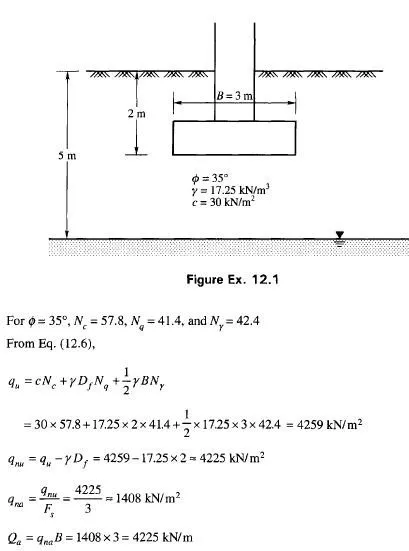The determination of bearing capacity of soil based on the classical earth pressure theory of Rankine (1857) began with Pauker, a Russian military engineer (1889), and was modified by Bell (1915). Pauker’s theory was applicable only for sandy soils but the theory of Bell took into account cohesion also. Neither theory took into account the width of the foundation. Subsequent developments led to the modification of Bell’s theory to include width of footing also.
The methods of calculating the ultimate bearing capacity of shallow strip footings by plastic theory developed considerably over the years since Terzaghi (1943) first proposed a method by taking into account the weight of soil by the principle of superposition. Terzaghi extended the theory of Prandtl (1921). Prandtl developed an equation based on his study of the penetration of a long hard metal punch into softer materials for computing the ultimate bearing capacity. He assumed the material was weightless possessing only cohesion and friction. Taylor (1948) extended the equation of Prandtl by taking into account the surcharge effect of the overburden soil at the foundation level.
No exact analytical solution for computing bearing capacity of footings is available at present because the basic system of equations describing the yield problems is nonlinear. On account of these reasons, Terzaghi (1943) first proposed a semi-empirical equation for computing the ultimate bearing capacity of strip footings by taking into account cohesion, friction and weight of soil, and replacing the overburden pressure with an equivalent surcharge load at the base level of the foundation. This method was for the general shear failure condition and the principle of superposition was adopted. His work was an extension of the work of Prandtl (1921). The final form of the equation proposed by Terzaghi is the same as the one given by Prandtl.
Subsequent to the work by Terzaghi, many investigators became interested in this problem and presented their own solutions. However the form of the equation presented by all these investigators remained the same as that of Terzaghi, but their methods of determining the bearing capacity factors were different.
Of importance in determining the bearing capacity of strip footings is the assumption of plane strain inherent in the solutions of strip footings. The angle of internal friction as determined under an axially symmetric triaxial compression stress state, 0f, is known to be several degrees less than that determined under plane strain conditions under low confining pressures. Thus the bearing capacity of a strip footing calculated by the generally accepted formulas, using 0r, is usually less than the actual bearing capacity as determined by the plane strain footing tests which leads to a conclusion that the bearing capacity formulas are conservative
The ultimate bearing capacity, or the allowable soil pressure, can be calculated either from bearing capacity theories or from some of the in situ tests. Each theory has its own good and bad points. Some of the theories are of academic interest only. However, it is the purpose of the author to present here only such theories which are of basic interest to students in particular and professional engineers in general. The application of field tests for determining bearing capacity are also presented which are of particular importance to professional engineers since present practice is to rely more on field tests for determining the bearing capacity or allowable bearing pressure of soil.
Some of the methods that are discussed in this chapter are
1. Terzaghi’s bearing capacity theory
2. The general bearing capacity equation
3. Field tests


